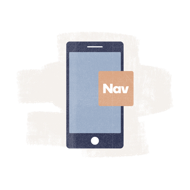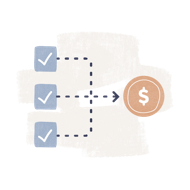Your accountant plays a crucial role in helping you allocate your business’s precious resources, so it’s important that you have a basic understanding of the terms they use as they go about their job and talk to you about your money.
Here are the four main financial statements used within a company that your accountant might want to prepare or discuss with you. These documents give a good overview of how your company is performing financially.
1. Income Statement (Profit & Loss Statement)
An income statement shows sources of revenues and expenses over a specific time period (usually month, quarter, or year). Revenues less expenses will show net profit on an income statement. This document is important for many reasons — one in particular is if you want to work with a lender, they will usually ask for a detailed P&L statement to evaluate your business for a loan, as well as your business credit report. (You can check your business credit data for free on Nav.)
2. Cash-Flow Statement (Statement of Cash Flows)
The cash-flow statement shows a business’s sources and uses of cash and cash equivalents (things like Treasury bills or money-market funds that can be quickly converted to cash). The statement separates cash from operating activities (the main activity the business is engaged in), investing activities (short- or long-term investments the company makes with its extra funds) and financing activities (any debt or equity).
3. Statement of Stockholder’s Equity
This document shows the changes in the value of the owners’, or shareholders’, equity in the company. A company will indicate any dividends paid and retained earnings that will be reinvested in the business on this statement.
4. Balance Sheet
A balance sheet shows all of a business’s assets, liabilities and stockholder’s equity at a given point in time. Assets are anything a company owns, like property, equipment, account receivables or inventory. Liabilities are debts your company owes, like accounts payable to service providers or a loan from the bank. Stockholder’s equity, or owner’s equity, is the amount of money put into the business by the company’s owners.
More Accounting Terms You Should Know
5. Accrual-Based Accounting
This is a form of accounting that recognizes expenses and revenues when they are incurred or earned. This means that you are NOT necessarily documenting when the money actually comes in or flows out of your business. This can cause some confusion for small businesses because accrual-based accounting can make it seem like a business has more cash on hand than it actually does, since some payments have not been collected and some expenses not yet paid.
Accrual-based accounting must be used for external reporting purposes, for example when you submit your financial statement to a bank or the IRS. Many small businesses, however, choose to use cash-based accounting for internal reporting purposes.
6. Cash-Based Accounting
Cash-based accounting records revenues and expenses when the cash is actually received or paid out. Cash-based is a good form of record keeping for small businesses because it gives a better picture of how much cash is actually flowing in and out of a business at a given point in time.
7. Contribution Margin
Contribution margin is an important concept for companies that produce more than one product or offer more than one service. It is calculated like this:
Sales – Variable Expenses = Contribution Margin
Comparing contribution margins of different products or services within a company is a good way to decipher which ones should be continued or discontinued when the company doesn’t have enough resources to support the production or selling of all products.
8. Net Income
Net income is a company’s total profit after expenses, including taxes and interest. This is different from net operating income, which is income before taxes and interest.
9. Opportunity Cost
Opportunity cost refers to the benefit foregone when one alternative is chosen over another.
Here’s a common example of opportunity cost for small businesses: One of your regular suppliers offers a discount when you pay early, say 2% off your bill if you pay within 10 days on a bill that is normally due in 60 days. That’s a nice discount and adds up if it’s a supplier you regularly work with and it can even improve your business’s Paydex credit score, but there’s also a cost associated with giving up your free cash 50 days earlier than planned. The opportunity cost is the other uses that cash could be put towards.
10. Relevant Costs
Relevant costs are costs that are avoidable, and are usually discussed in regards to making a particular decision about the business.
For example, if you are deciding whether or not to make or buy a part involved in producing your product, you’ll want to consider what costs are avoidable if you make versus which costs are avoidable if you buy. This helps to make the call based on which decision is better financially.
11. Return on Assets
Your accountant may want to measure the efficiency of assets in a business. Return on assets is generally calculated like this:
Return on Assets = Net Income / Average Total Assets
An example of how this might be used is to decide whether it’s time to update equipment or sell unused items.
12. Topline Revenue
Topline revenue refers to gross sales or revenues generated by a company. This figure will show up as the first item on your income statement. This number is very important for businesses seeking loans, as lenders will want to know about this number.
13. Variable and Fixed Costs
Variable costs are costs that vary with production, where fixed costs are ones that will not change when production changes. Variable costs include things like raw materials or sales commissions. Fixed costs are things like rent or salaries to employees. Knowing the difference can help you make informed decisions on where to cut costs.
Some costs are mixed, which means part of the cost is variable and part fixed. The cost of a car could be considered a mixed cost — you pay a fixed amount for insurance each month but the cost of gas varies based on how much you use the car.
14. Working Capital
Working capital measures the ability of a company to cover its short term debts using short term assets. It is calculated like this:
Working Capital = Current Assets – Current Liabilities
Where current assets are assets that can be liquidated in 12 months or less, and current liabilities are debts that must be repaid within 12 months.
This article was originally written on May 12, 2017 and updated on May 15, 2017.



Have at it! We'd love to hear from you and encourage a lively discussion among our users. Please help us keep our site clean and protect yourself. Refrain from posting overtly promotional content, and avoid disclosing personal information such as bank account or phone numbers.
Reviews Disclosure: The responses below are not provided or commissioned by the credit card, financing and service companies that appear on this site. Responses have not been reviewed, approved or otherwise endorsed by the credit card, financing and service companies and it is not their responsibility to ensure all posts and/or questions are answered.